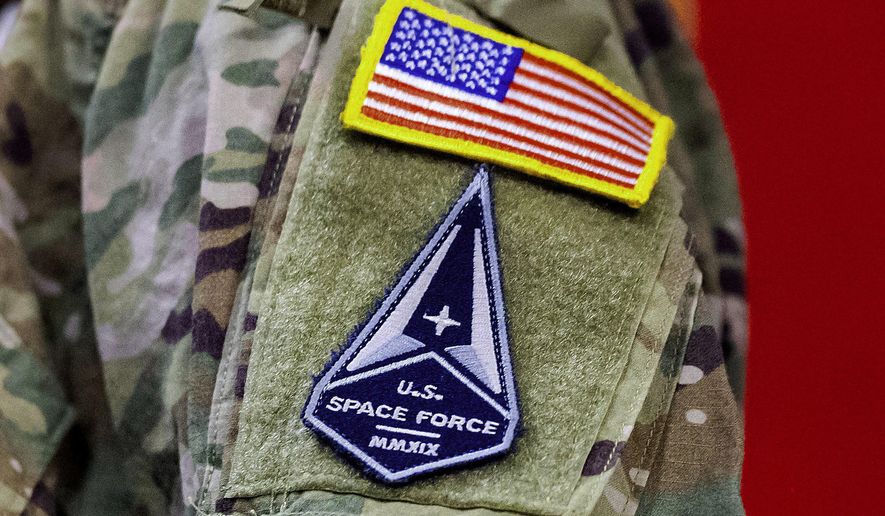A version of this story appeared in the daily Threat Status newsletter from The Washington Times. Click here to receive Threat Status delivered directly to your inbox each weekday.
The U.S. Air Force combat wings will be turned into “units of action” designed to better fight a war with China under a major reorganization of the service and its new sub-service, the Space Force, announced by senior service leaders this week.
The sweeping restructuring blueprint calls for upping military readiness and the ability to project power for the air and space forces. New weapons and high-technology warfighting capabilities will be developed under the plan, all to meet the challenge of a rising, more assertive China in East Asia.
“The People’s Republic of China’s (PRC’s) military advancements threaten our intended mode of warfare and utilize assertive strategies to impose costs and deny U.S. power-projection capabilities,” the Air Force said in a report made public Monday. It noted additional threats from Russia, North Korea and Middle East terrorists. China’s military advances pose a “stark and compelling challenge,” the report said.
Operational air wings will be changed to units called “deployable combat” wings, “in-place combat” wings and “combat generation” wings.
The goal of the restructuring is to create more agile, faster-moving forces. Combat wings will better prepare for warfighting, and base commands will do more to support the wings.
The Air Force also will create a stand-alone command devoted to waging cyberwarfare and defending against anticipated cyberattacks.
Aging U.S. nuclear forces, two-thirds of which are Air Force land-based missiles and nuclear bombers, will be enhanced under the reforms.
The Nuclear Weapons Center in charge of strategic command and control for Minuteman III missiles and nuclear B-52 bombers is being expanded.
“We cannot afford to be complacent, holding on to outdated structures,” Air Force Chief of Staff Gen. David W. Allvin said when announcing the plan. “The Air Force built for the previous era is no longer optimized for the current strategic landscape.”
Change within the service is “not an option but a necessity,” the four-star general said. “We must adapt to effectively demonstrate our readiness and capability to deter and, if required, to prevail in conflict.”
Beijing has taken notice of the Pentagon’s efforts to upgrade its capabilities in the air and outer space.
The Chinese Communist Party-affiliated Global Times said the Air Force reorganization plan reflects a growing recognition by the Pentagon of China’s “many and multiplying advantages” in a head-to-head competition with the U.S.
“However, when comparing the balance of U.S. and Chinese power, the U.S. seems to automatically add ‘inherent supremacy’ to its column and neglect its disadvantages,” the outlet stated. “What it prepares for is one of the most senseless and avoidable potential wars in human history.”
Struggling to compete
Reports say U.S. military personnel struggled to counter Chinese forces in recent war games.
The House Select Committee on the Chinese Communist Party simulated a Chinese invasion of Taiwan in April. The exercise revealed that U.S. forces would sustain high losses and rapid depletion of long-range missiles while intervening to halt the invasion.
The Air Force did not provide details on what new weapons and capabilities it would seek under the reforms. About 450 F-35 jets are deployed, and plans call for buying 2,500 F-35s for an estimated $1.7 trillion.
It was unclear from the announced reforms whether the F-35 would remain the mainstay of Air Force power projection.
Missiles under development include the Sentinel intercontinental ballistic missiles, the air-to-ground stand-in attack weapon known as SiAW, the air-to-air joint advanced tactical weapon and long-range stand-off cruise missiles.
The air-launched rapid response weapon (ARRW), a hypersonic missile that the Air Force developed to match high-speed missiles deployed by China, has encountered testing difficulties.
An Air Force drone, the “collaborative combat aircraft,” is also being built. The drone will be used for bombing, surveillance, electronic warfare and deception. The XQ-58A Valkyrie combat drone was flown for the first time in July.
Improving weapons development and streamlining cumbersome arms acquisition under the reforms will result in “a more agile and technologically advanced warfighting posture,” the report said.
In announcing the service’s mission overhaul, Air Force Secretary Frank Kendall said the changes are needed now. “We are out of time to reoptimize our forces to meet the strategic challenges in a time of great-power competition.”
Mr. Kendall outlined the reforms in a September memorandum. He said they reflected the need for the Air Force to be better postured for dealing with threats posed by China.
“It has been clear to me for over a decade that China is intent on fielding a force that can conduct aggression in the Western Pacific and prevail even if the United States intervenes,” he said. “While China has focused on creating the regional conventional forces it believes it needs, China is also dramatically expanding its nuclear force and military space capabilities. We cannot sustain deterrence by standing still.”
‘Geriatric’ inventory
The Air Force and Space Force restructuring focuses on four areas: improving personnel, increasing military readiness, projecting power and building capabilities.
Air Combat Command will be reoriented to better prepare lethal forces for combatant commanders. Large-scale military exercises are planned, and more inspections will be held to test readiness. An Information Dominance System Center will be set up to improve command and control, battle management, and cyberspace and electronic warfare.
Retired Air Force Lt. Gen. David Deptula said the announced reforms reveal that the Air Force lacks the resources it needs to fulfill the missions assigned by combatant commands.
The reforms show the service “drastically needs to not only modernize its geriatric inventory of aircraft, but it also has to optimize how it trains, develops and organizes to integrate all its actions to best meet the threats of today and tomorrow,” said Gen. Deptula, a former deputy chief of staff for intelligence.
“Today, the Air Force is the oldest, smallest and least ready in its history due to chronic underfunding over the past 30 years,” he said.
The service leadership seeks to remedy the shortfalls while coping with constrained resources.
The fledgling Space Force will employ “units of action” for operations in space to prevent enemies from attacking or degrading satellite systems used for missile warning, navigation and communications.
The Space Force report on the reforms did not mention China but referred to threats using the acronym GPC for “great power competition.”
China is thought to have advanced space warfare capabilities, including several types of ground-based missiles capable of destroying satellites, electronic jammers and laser weapons, and roving robot satellites that can grab and crush satellites.
The Space Force, despite billing itself as a warfighting force, has announced a single-deployed weapons system, a ground-based electronic satellite jammer.
Gen. Chance Saltzman, chief of Space Force operations, stated in the report that a great power’s military “must have the capacity to engage in protracted, day-to-day competition with its rival.”
The Space Force still has “organizational constructs, processes and policies that are sub-optimized for the great power security environment,” he said. “Therefore, we must implement enterprise-wide changes that can better prepare the USSF for this type of challenge.”
• Bill Gertz can be reached at bgertz@washingtontimes.com.




Please read our comment policy before commenting.